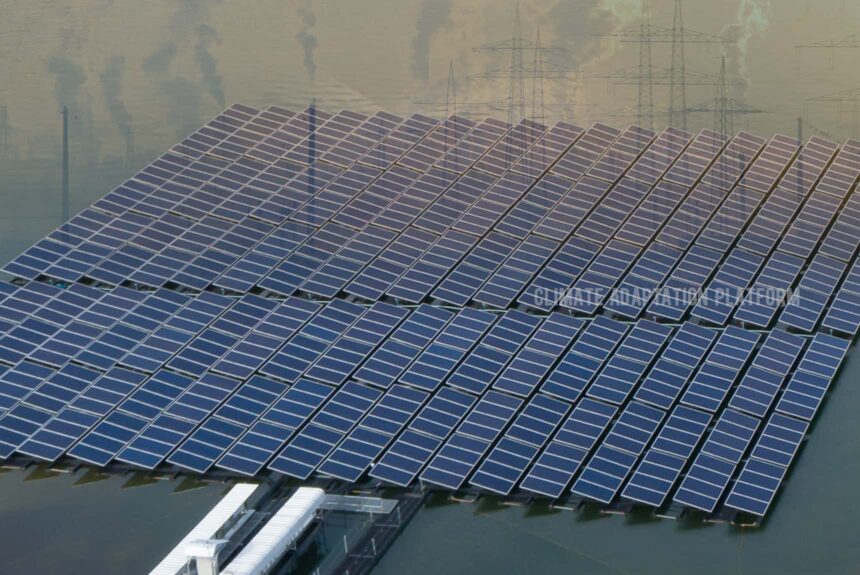As people transition from fossil fuels to a cleaner option, electricity demands will increase to power electric cars and fleets and replace coal and gas in industrial applications.
Continuous innovation in the solar power industry makes it the most preferred renewable energy source for commercial, residential and government applications. Scaling up solar power has the potential to decarbonise the electricity sector.
The article, “Floating solar power could help fight climate change – lets’ get it right”, shows the potential of floatovoltaics to decarbonise electricity. The paper says that when floatovoltaics are installed in 10% of the world’s hydropower reservoirs, they can provide the same electrical capacity as all existing fossil-fuel power plants.
Floatovoltaics, as the names suggest, are solar panels attached with floaters so that they can be placed on water surfaces instead of land. In countries where land is scarce, and there is a competition to use it for agriculture or to grow food, deploying solar panels on water, particularly on reservoirs, can be the best option.
Although solar panels can be installed in deserts where there is abundant sunshine and no competition for land, there are still trade-offs to consider.
According to the paper, modelling shows that dark colours from the vast areas of solar panels can alter local temperatures and global airflow patterns that can lead to droughts in the Amazon and melt the ice in the Arctic and other regions. Besides these trade-offs, there are logistical challenges in moving energy from remote places.
Floatovoltaics is a growing industry
As of 2020, the global installed capacity of floatovoltaics was just 3 GW compared with more than 700 GW for land-based solar panels. However, the paper points out its massive potential for expansion given the vast numbers of reservoirs worldwide.
Why should floatovaltaics be deployed on reservoirs and not just on any body of water?
Almeida, Schmitt, et al. (2022) explains why reservoirs are the most strategic areas to place these floating solar panels:
- Floatovoltaics are conventional solar panels installed on floats that are anchored through mooring lines. Proximity to water tends to keep them cool, making floating panels about 5% more efficient than land-based ones.
- Arrays shield the surface from the sun and might reduce evaporation, retaining water for hydropower, drinking and irrigation.
- Hydropower reservoirs already have the grid infrastructure for conveying electricity to consumers, reducing transmission costs. Pairing solar with pumped-storage hydropower could address the twin challenges of providing energy when sunlight is weak and storing it as potential energy in reservoirs when solar-power production is high.
- For some of those sites, putting solar panels over just 2% of the reservoir’s surface could double the electricity production, halving carbon intensity —an important metric in climate policy.
But as with every new technology, the rapid scaling up of floatovoltaics may have unforeseen consequences. Wind turbines, for example, have harmed birds and bats, and their installation offshore can create noise pollution for marine life, interfere with whale migrations and pose complications for commercial fisheries (Almeida, Schmitt, et al., 2022).
Almeida, Schmitt, et al. (2022) note that when it comes to floatovoltaics, trade-offs between its expansion and the environmental, social, and economic impacts are largely unexplored in both concepts and practice.
For instance, how much of any given reservoir could be covered before the downsides outweigh the advantages. Modelling shows that warming is increasing the harmful algal blooms in water bodies, and floatovoltaics can counter these, but only when half of the water surface is covered.
The paper notes that there are still many things to know about the consequences of placing arrays of solar panels on water bodies on its biological processes, drinking-water quality, aquatic and terrestrial life, and downstream ecosystems (Almeida, Schmitt, et al., 2022).
Neglecting these trade-offs could increase public opposition to floatovoltaics, lengthen the environmental-impact approval process and deter private investors, thus hampering the decarbonisation shift (Almeida, Schmitt, et al., 2022).
Click the link we provided in the “Source” to read the entire paper.
Source:
Almeida, R., Schmitt, R., Grodsky, S., Flecker, A., Gomes, C., Zhao, L., Liu, H., Barros, N., Kelman, R., & McIntyre, P. (2022 June 7). Floating solar power could help fight climate change – let’s get it right. Nature. Retrieved from https://www.nature.com/articles/d41586-022-01525-1



Leave a Reply